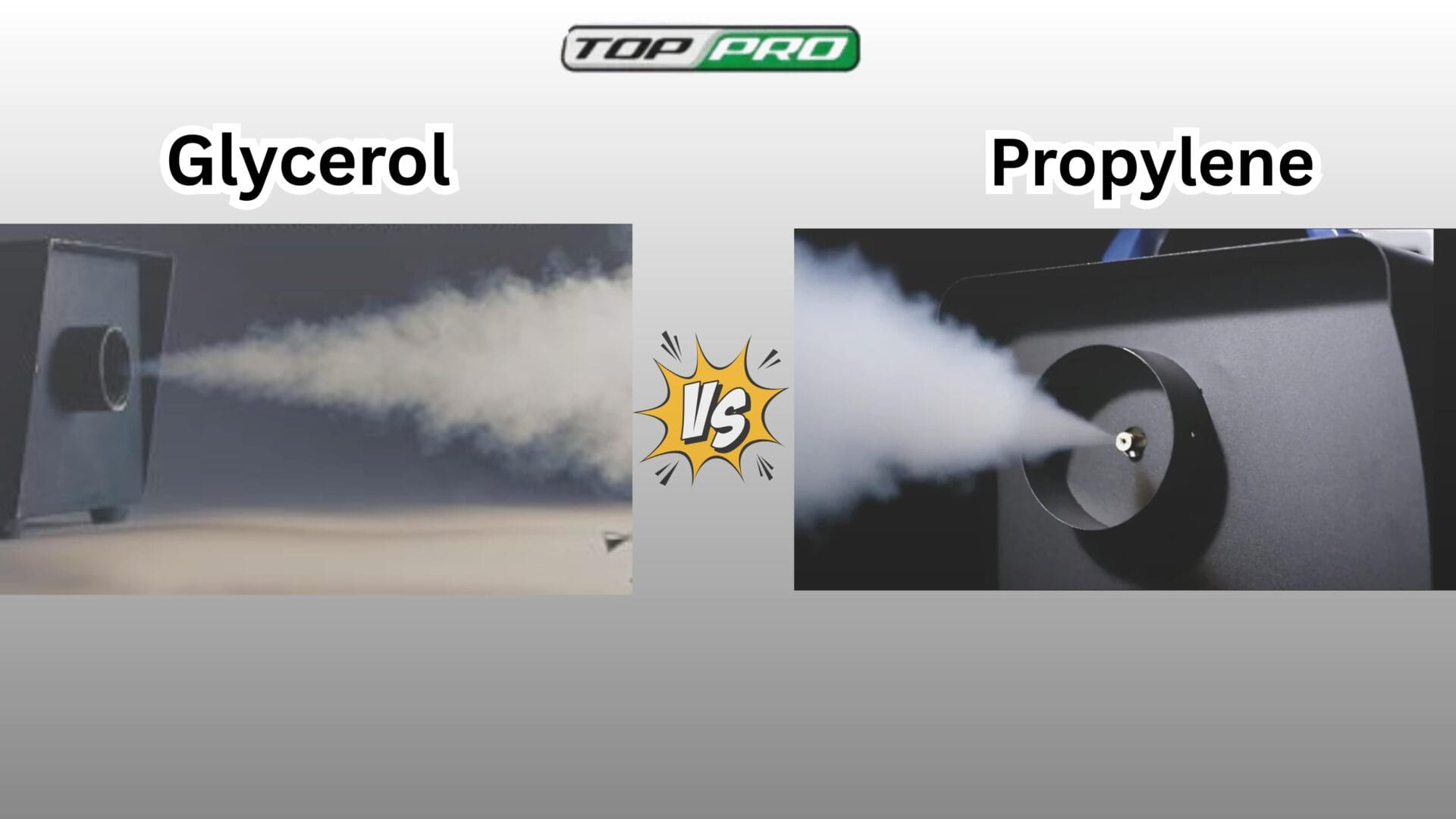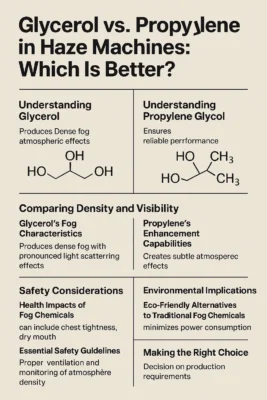Glycerol vs. Propylene in Haze Machines: Which Is Better?

When it comes to creating atmospheric effects in theatrical productions, cinematic production, and film productions, the choice between glycerol and propylene glycol in haze machines can significantly impact your results. This comprehensive guide examines both options to help you make an informed decision for your specific needs.
Understanding Glycerol
Glycerol, also known as glycerin fog base, represents one of the most widely used key ingredients in professional fog juice formulations. This colorless, viscous liquid possesses unique properties that make it ideal for creating dense atmospheric effects. Glycerol occurs naturally in many food products and personal care products, contributing to its reputation as a relatively safe option for indoor use.
The molecular structure of glycerol allows it to produce solid particles when heated and dispersed through fog machines. These particles tend to be larger and more stable than those produced by other chemicals, resulting in longer-lasting effects that maintain their density over extended periods. 
Understanding Propylene Glycol
Propylene glycol serves as another fundamental component in professional fog juice formulations. Unlike ethylene glycol, which poses significant health risks, propylene glycol maintains an excellent safety profile while delivering reliable performance. This compound appears in numerous food products and personal care products, indicating its general safety for human exposure under normal circumstances.
The lighter molecular weight of propylene glycol compared to triethylene glycol results in finer particle dispersion when processed through haze generators. This characteristic makes propylene glycol particularly suitable for creating subtle atmospheric effects that enhance lighting without overwhelming the visual field.
Function as a Fog Enhancer
Propylene glycol excels as a fog enhancer, working synergistically with other key ingredients to optimize atmospheric effects. Its lower viscosity compared to glycerol allows for smoother operation through fog machine systems, reducing maintenance requirements and extending equipment lifespan. Many fluid manufacturer formulations combine propylene glycol with other compounds to achieve specific density and longevity characteristics.
The versatility of propylene glycol makes it suitable for various applications, from intimate theatrical productions to large-scale cinematic production environments. Its ability to create fine, even particle distribution ensures consistent atmospheric effects across different lighting conditions and venue sizes.
Comparing Density and Visibility
Glycerol’s Fog Characteristics
Glycerol produces characteristically dense fog with excellent visibility under stage lighting. The larger particle size creates pronounced light scattering effects, making light beams highly visible and dramatic. This property makes glycerol particularly valuable for productions requiring bold atmospheric statements.
The persistence of glycerol-based effects means that once atmospheric density is established, it maintains consistency for extended periods. This stability reduces the need for continuous haze machine operation, allowing for more precise control over atmospheric timing during performances.
Propylene’s Enhancement Capabilities
Propylene glycol creates more subtle atmospheric effects with finer particle distribution. While the density may appear lower than glycerol-based alternatives, propylene glycol excels at enhancing existing lighting without creating overwhelming atmospheric presence. This characteristic makes it ideal for productions requiring nuanced atmospheric control.
The lighter nature of propylene glycol-based fog allows for more dynamic atmospheric effects that can quickly dissipate when desired. This flexibility proves valuable in productions requiring rapid scene transitions or varying atmospheric intensities throughout a performance.
Safety Considerations
Health Impacts of Fog Chemicals
Short-term exposure to properly formulated fog juice typically produces minimal health effects in most individuals. However, some people may experience chest tightness or dry mouth when exposed to atmospheric effects, particularly in poorly ventilated spaces. Professional productions must consider these potential reactions when planning atmospheric effects.
The safety profile differs significantly between various compounds used in fog juice formulations. While exposure to mineral oil-based products can cause respiratory irritation, properly formulated glycol-based fogs generally present fewer health concerns. Regular monitoring of atmospheric conditions and adequate ventilation help minimize potential risks.
Essential Safety Guidelines
Professional use of haze machines requires adherence to strict safety protocols. Operators should ensure adequate ventilation in all performance spaces and monitor atmospheric density to prevent excessive accumulation of heat. Regular equipment maintenance and proper storage of fog juice contribute to safe operation.
Understanding the distinction between different fog juice formulations helps operators make informed safety decisions. Products containing ethylene glycol should be avoided due to toxicity concerns, while those based on propylene glycol or glycerol typically offer better safety profiles for indoor use.
Environmental Implications
Eco-Friendly Alternatives to Traditional Fog Chemicals
The entertainment industry increasingly seeks environmentally responsible alternatives to traditional fog chemicals. Some manufacturers now offer bio-based fog juice formulations that maintain performance standards while reducing environmental impact. These alternatives often utilize renewable sources and biodegradable compounds.
Water-based fog systems present another environmentally conscious option, though they may not achieve the same density and persistence as glycol-based alternatives. The choice between environmental responsibility and performance requirements often requires careful consideration of production needs and venue characteristics.

Energy-Efficient Practices for Haze Machines
Modern haze generators incorporate energy-efficient heating elements that reduce power consumption while maintaining consistent output. Proper maintenance and calibration of equipment ensure optimal performance with minimal energy waste. Strategic placement of haze machines can maximize coverage while minimizing the number of units required.
Remote control capabilities allow operators to optimize atmospheric effects timing, reducing unnecessary operation and energy consumption. Smart programming of haze machines based on production schedules can significantly reduce overall energy usage while maintaining required atmospheric effects.
Public Perception and Misconceptions
Concerns Beyond Vaping Applications
Public awareness of fog machine safety has increased due to discussions surrounding vaping and e-cigarette use. While the chemicals used in professional fog juice may be similar to those in vaping products, the application, concentration, and exposure methods differ significantly. Professional atmospheric effects typically involve lower concentrations and better ventilation than personal vaping devices.
Understanding these distinctions helps address public concerns while maintaining professional standards. Proper communication about safety measures and chemical compositions can help build confidence in professional atmospheric effects applications.
Balanced View on Glycerol and Propylene Use
Both glycerol and propylene glycol have established safety records in various applications beyond atmospheric effects. Their use in food products and personal care products demonstrates general safety under normal exposure conditions. However, professional applications require appropriate safety measures regardless of the specific compounds used.
The key to safe operation lies in proper ventilation, appropriate concentration levels, and adherence to manufacturer guidelines. Regular training of operators and maintenance of equipment ensure that atmospheric effects enhance productions without compromising safety.
Making the Right Choice
The decision between glycerol and propylene glycol ultimately depends on your specific production requirements. Glycerol excels in applications requiring dense, persistent fog effects, while propylene glycol offers more subtle enhancement capabilities with greater operational flexibility.
Consider factors such as venue size, ventilation capabilities, desired effect intensity, and equipment compatibility when making your selection. Many professional productions benefit from having both options available, allowing for tailored atmospheric effects based on specific scene requirements.
By understanding the characteristics and applications of different fog juice formulations, production professionals can make informed decisions that enhance their creative vision while maintaining the highest standards of safety and environmental responsibility.







